Simple and Low-Cost Photovoltaic Module Emulator
Abstract
1. Introduction
2. PV Cell Model and Characteristics
- Short-circuit current ISC: the maximum current that can be supplied by a photovoltaic cell under short-circuit conditions (V = 0);
- Open circuit voltage VOC: the maximum voltage drop at the cell terminals when the supplied current is null;
- Maximum power point MPP: the point of the I–V characteristic (Vmax, Imax) where the power supplied to the load is maximum;
- Fill Factor FF = (Vmax × Imax)/(VOC × ISC): a parameter that measures the quality of the cell;
- Conversion efficiency η, defined as the ratio between the maximum power produced by the cell and the total power incident on its surface at STC.
- RS is the series resistance that models the internal losses of the cell due to the sum of the resistive contributions inside the cell and the contact resistance;
- RSH is the shunt resistance that models the effects of leakage currents in the p-n junction mainly due to manufacturing defects in the photovoltaic cell.
3. Description of the PV Source Emulator
3.1. System Overview
3.2. Emulation Technique
- A current generator capable of delivering a constant current equal to ISC in the voltage range from 0 to VOC;
- A control system capable of determining, for each voltage, the value of the current ILOSS required to subtract to the load;
- A power MOSFET that drain ILOSS from the branch in which the ISC flows.
3.3. Experimental Setup
4. Results
4.1. Simulation Results
4.2. Experimental Results
4.1.1. Results at Different Environmental Conditions
4.1.2. Dynamic Performance
5. Conclusions
Author Contributions
Funding
Acknowledgments
Conflicts of Interest
References
- Piliougine, M.; Carretero, J.; Mora-López, L.; Sidrach-De-Cardona, M. Experimental system for current-voltage curve measurement of photovoltaic modules under outdoor conditions. Prog. Photovolt. 2011, 19, 591–602. [Google Scholar] [CrossRef]
- Camino-Villacorta, M.; Egido-Aguilera, M.A.; Díaz, P. Test procedures for maximum power point tracking charge controllers characterization. Prog. Photovolt. Res. Appl. 2012, 20, 310–320. [Google Scholar] [CrossRef]
- Elgar TerraSAS ETS Series. Available online: https://www.powerandtest.com (accessed on 24 October 2019).
- Keysight E4368A Solar Array Simulator. Available online: https://www.keysight.com (accessed on 24 October 2019).
- Magna-Power Programmable DC Power Supply. Available online: http://www.magna-power.com (accessed on 24 October 2019).
- Sanchis, P.; López, J.; Ursúa, A.; Gubía, E.; Marroyo, L. On the testing, characterization, and evaluation of PV inverters and dynamic MPPT performance under real varying operating conditions. Prog. Photovolt. 2007, 15, 541–556. [Google Scholar] [CrossRef]
- Mukerjee, A.; Dasgupta, N. DC power supply used as photovoltaic simulator for testing MPPT algorithms. Renew. Energy 2007, 32, 587–592. [Google Scholar] [CrossRef]
- Nagayoshi, H. I–V curve simulation by multi-module simulator using I–V magnifier circuit. Sol. Energy Mater. Sol. Cells 2004, 82, 159–167. [Google Scholar] [CrossRef]
- Midtgard, O.-M. A simple photovoltaic simulator for testing of power electronics. In Proceedings of the 2007 European Conference on Power Electronics and Applications, Aalborg, Denmark, 2–5 September 2007; pp. 1–10. [Google Scholar]
- Zhou, Z.; Macaulay, J. An Emulated PV Source Based on an Unilluminated Solar Panel and DC Power Supply. Energies 2017, 10, 2075. [Google Scholar] [CrossRef]
- Moussa, I.; Khedher, A.; Bouallegue, A. Design of a Low-Cost PV Emulator Applied for PVECS. Electronics 2019, 8, 232. [Google Scholar] [CrossRef]
- Sanaullah, A.; Khan, H.A. Design and implementation of a low cost Solar Panel emulator. In Proceedings of the 2015 IEEE 42nd Photovoltaic Specialist Conference (PVSC), New Orleans, LA, USA, 14–19 June 2015. [Google Scholar]
- Koutroulis, E.; Kalaitzakis, K.; Tzitzilonis, V. Development of an FPGA-based system for real-time simulation of photovoltaic modules. Microelectron. J. 2009, 40, 1094–1102. [Google Scholar] [CrossRef]
- Rana, A.V.; Patel, H.H. Current Controlled Buck Converter based Photovoltaic Emulator. J. Ind. Intell. Inf. 2013, 1, 91–96. [Google Scholar] [CrossRef]
- Walker, D.; Fisher, T.; Liu, J.; Schrimpf, R. Thermal modeling of single event burnout failure in semiconductor power devices. Microelectron. Reliab. 2001, 41, 571–578. [Google Scholar] [CrossRef]
- González-Medina, R.; Patrao, I.; Garcerá, G.; Figueres, E. A low-cost photovoltaic emulator for static and dynamic evaluation of photovoltaic power converters and facilities. Prog. Photovolt. Res. Appl. 2014, 22, 227–241. [Google Scholar] [CrossRef]
- Di Piazza, M.C.; Vitale, G. Photovoltaic field emulation including dynamic and partial shadow conditions. Appl. Energy 2010, 87, 814–823. [Google Scholar] [CrossRef]
- Koran, A.; LaBella, T.; Lai, J.S. High Efficiency Photovoltaic Source Simulator with Fast Response Time for Solar Power Conditioning Systems Evaluation. IEEE Trans. Power Electron. 2014, 29, 1285–1297. [Google Scholar] [CrossRef]
- Khouzam, K.; Hoffman, K. Real-time simulation of photovoltaic modules. Sol. Energy 1996, 56, 521–526. [Google Scholar] [CrossRef]
- Chang, C.-H.; Chang, E.-C.; Cheng, H.-L. A High-Efficiency Solar Array Simulator Implemented by an LLC Resonant DC–DC Converter. IEEE Trans. Power Electron. 2013, 28, 3039–3046. [Google Scholar] [CrossRef]
- Ortiz-Rivera, E.I.; Peng, F.Z. Analytical model for a photovoltaic module using the electrical characteristics provided by the manufacturer data sheet. In Proceedings of the IEEE 36th Power Electronics Specialists Conference, Recife, Brazil, 16 June 2005; pp. 2087–2091. [Google Scholar] [CrossRef]
- Zhang, H.; Zhao, Y. Research on a novel digital photovoltaic array simulator. In Proceedings of the International Conference on Intelligent Computation Technology and Automation, Changsha, China, 11–12 May 2010; Volume 2, pp. 1077–1080. [Google Scholar] [CrossRef]
- Balato, M.; Costanzo, L.; Gallo, D.; Landi, C.; Luiso, M.; Vitelli, M. Design and implementation of a dynamic FPAA based photovoltaic emulator. Sol. Energy 2016, 123, 102–115. [Google Scholar] [CrossRef]
- Zhang, J.; Wang, S.; Wang, Z.; Tian, L. Design and Realization of a Digital PV Simulator with a Push-Pull Forward Circuit. J. Power Electron. 2014, 14, 444–457. [Google Scholar] [CrossRef]
- Kim, Y.; Lee, W.; Pedram, M.; Chang, N. Dual-mode power regulator for photovoltaic module emulation. Appl. Energy 2013, 101, 730–739. [Google Scholar] [CrossRef]
- Iero, D.; Carbone, R.; Carotenuto, R.; Felini, C.; Merenda, M.; Pangallo, G.; Della Corte, F.G. SPICE modelling of a complete photovoltaic system including modules, energy storage elements and a multilevel inverter. Sol. Energy 2014, 107, 338–350. [Google Scholar] [CrossRef]
- Protogeropoulos, C.; Brinkworth, B.J.; Marshall, R.H.; Cross, B.M.; Santos, G. Evaluation of Two Theoretical Models in Simulating the Performance of Amorphous—Silicon Solar Cells. In Proceedings of the International Conference, Lisbon, Portugal, 8–12 April 1991; Springer Science and Business Media LLC.: Berlin, Germany, 1991; pp. 412–415. [Google Scholar]
- Chan, D.; Phang, J. Analytical methods for the extraction of solar-cell single- and double-diode model parameters from I-V characteristics. IEEE Trans. Electron Devices 1987, 34, 286–293. [Google Scholar] [CrossRef]
- Gow, J.; Manning, C. Development of a photovoltaic array model for use in power-electronics simulation studies. IEE Proc. Electr. Power Appl. 1999, 146, 193. [Google Scholar] [CrossRef]
- Iero, D.; Carbone, R.; Carotenuto, R.; Felini, C.; Merenda, M.; Pangallo, G.; Della Corte, F.G. One-shot SPICE simulation of photovoltaic modules, storage elements, inverter and load. In Proceedings of the 2015 AEIT International Annual Conference (AEIT), Naples, Italy, 14–16 October 2015; pp. 1–4. [Google Scholar]
- Bellia, H.; Youcef, R.; Fatima, M. A detailed modeling of photovoltaic module using MATLAB. NRIAG J. Astron. Geophys. 2014, 3, 53–61. [Google Scholar] [CrossRef]
- Ramos-Hernanz, J.; Campayo, J.; Larranaga, J.; Zulueta, E.; Barambones, O.; Motrico, J.; Gamiz, U.; Zamora, I. Two photovoltaic cell simulation models in Matlab/Simulink. Int. J. Tech. Phys. Probl. Eng. 2012, 4, 45–51. [Google Scholar]
- Walker, G. Evaluating MPPT converter topologies using a matlab PV model. J. Electr. Electron. Eng. Aust. 2001, 21, 49–55. [Google Scholar]
- Izadian, A.; Pourtaherian, A.; Motahari, S. Basic model and governing equation of solar cells used in power and control applications. In Proceedings of the IEEE Energy Conversion Congress and Exposition (ECCE), Raleigh, NC, USA, 15–20 September 2012; pp. 1483–1488. [Google Scholar]
- Pukhrem, S. A Photovoltaic Panel Model in Matlab/Simulink; The MathWorks, Inc.: Natick, MA, USA, 2013; pp. 20–23. [Google Scholar] [CrossRef]
- Merenda, M.; Iero, D.; Pangallo, G.; Falduto, P.; Adinolfi, G.; Merola, A.; Graditi, G.; Della Corte, F.G. Open-Source Hardware Platforms for Smart Converters with Cloud Connectivity. Electronics 2019, 8, 367. [Google Scholar] [CrossRef]
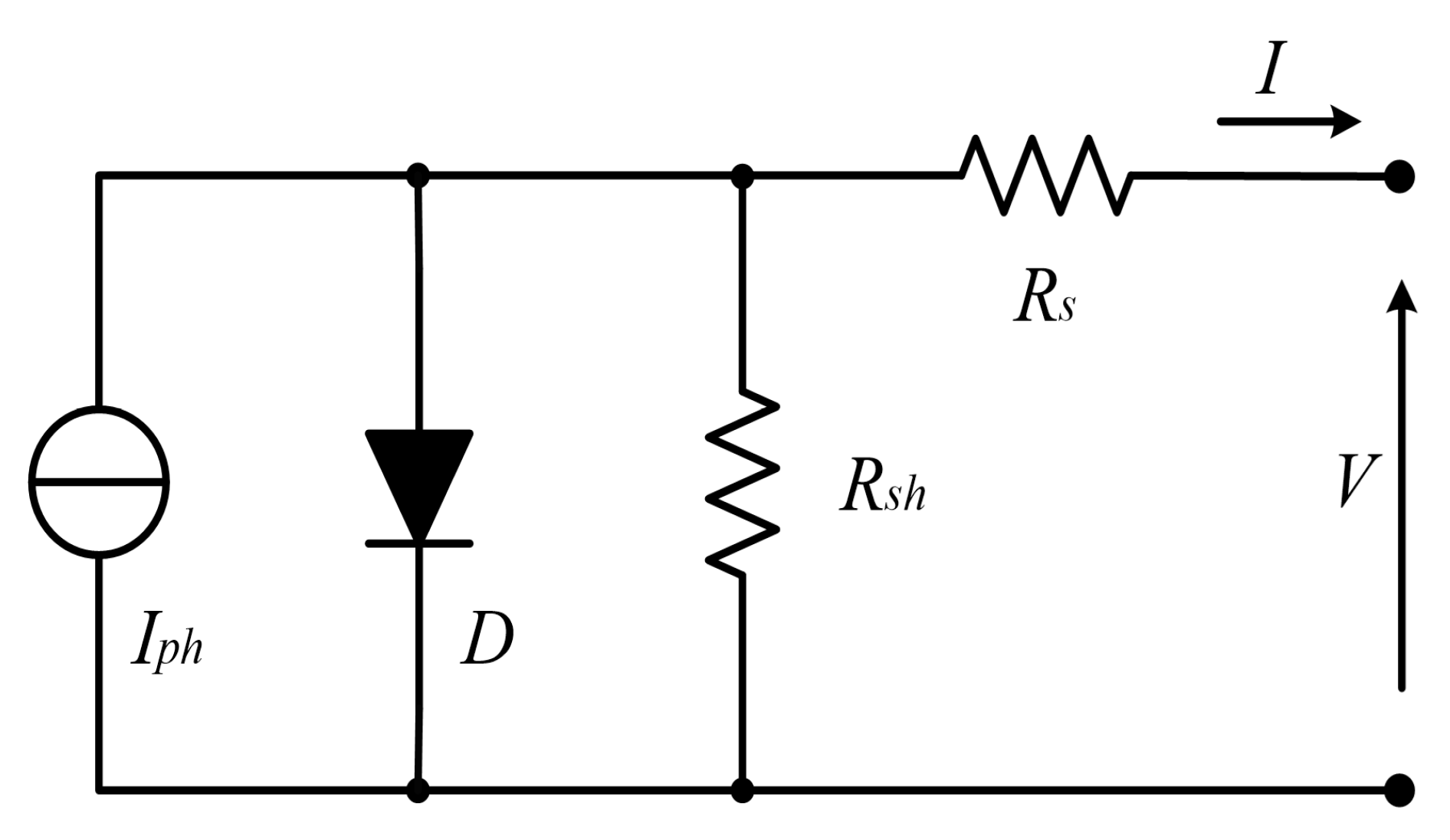
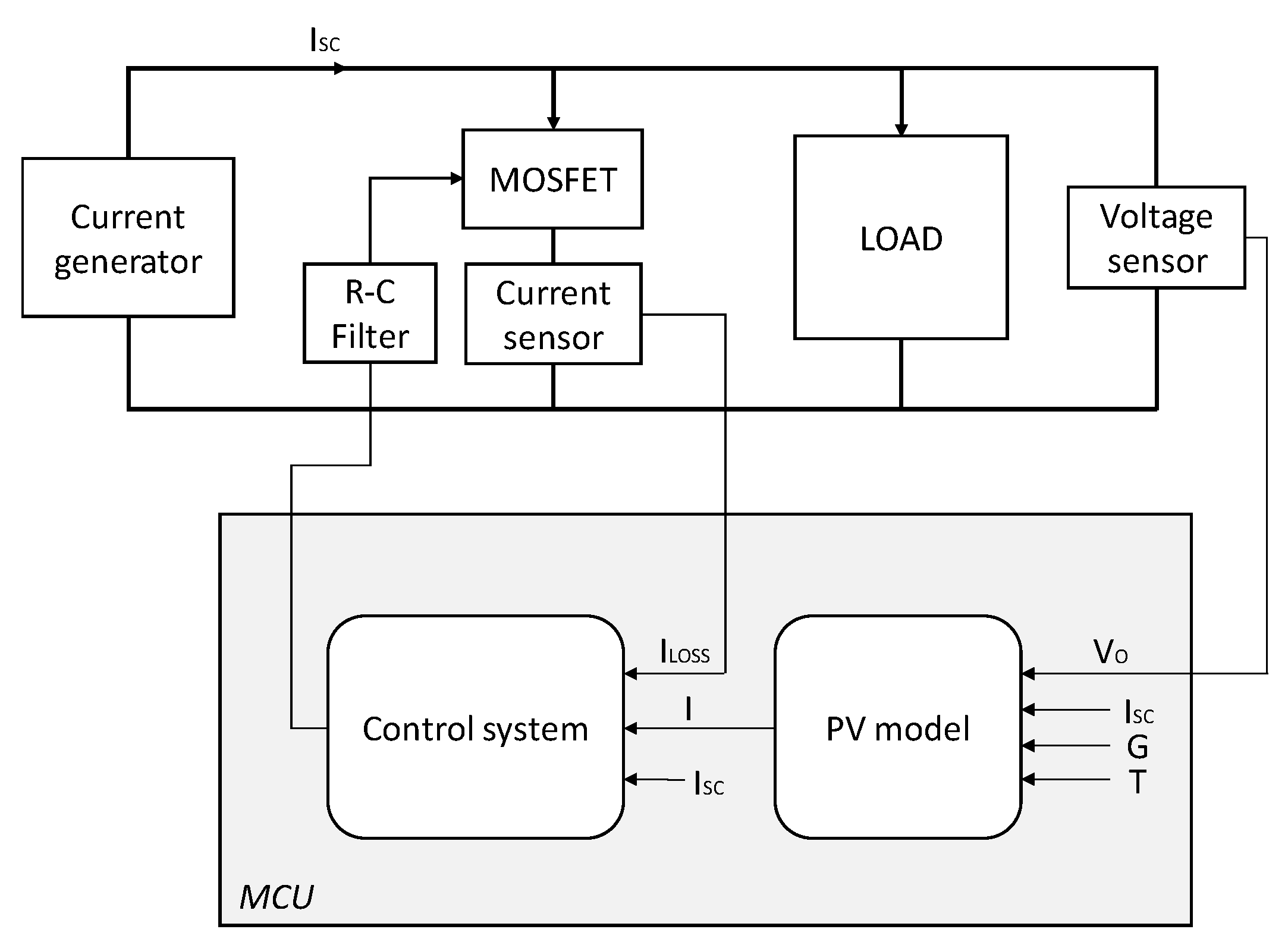
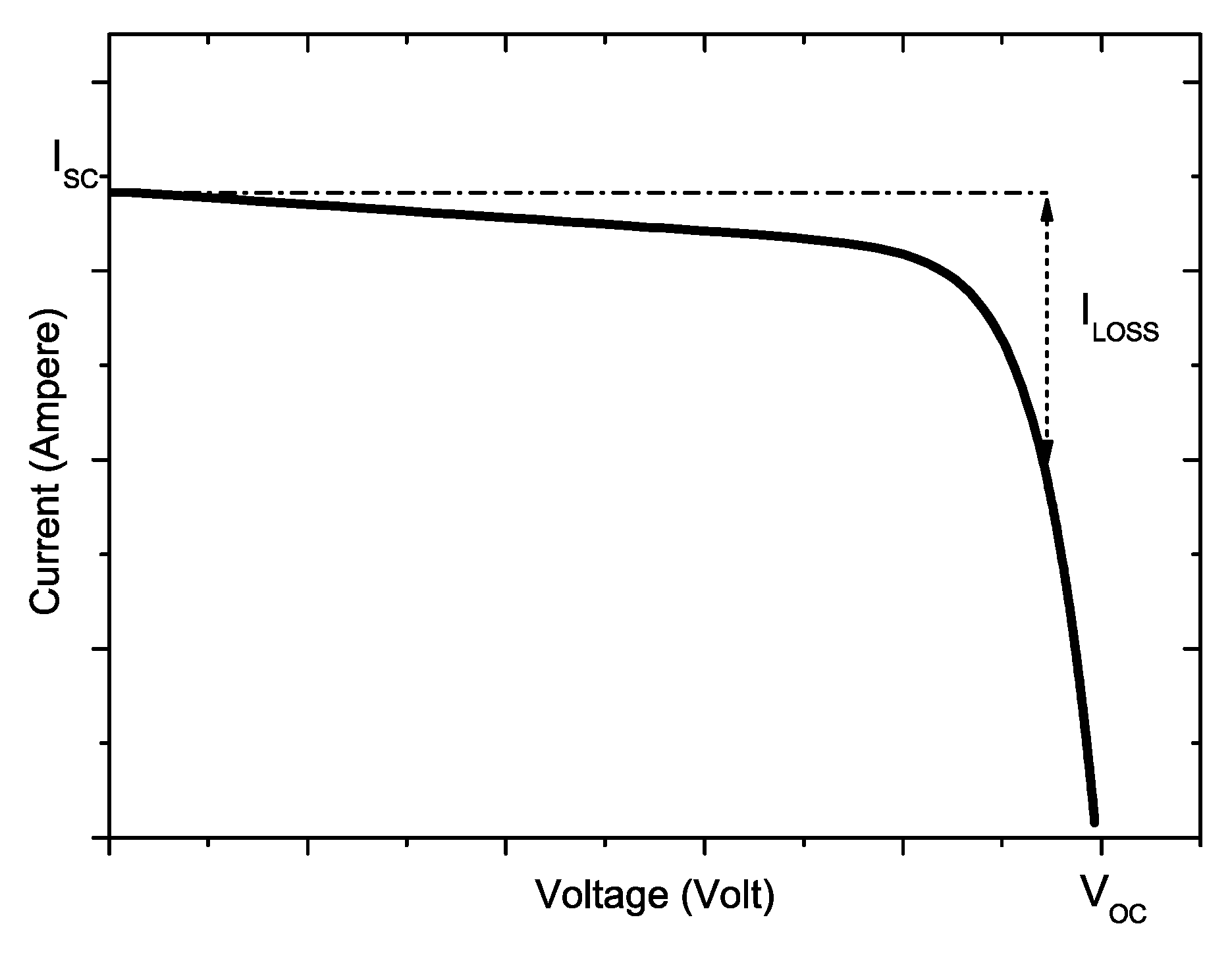
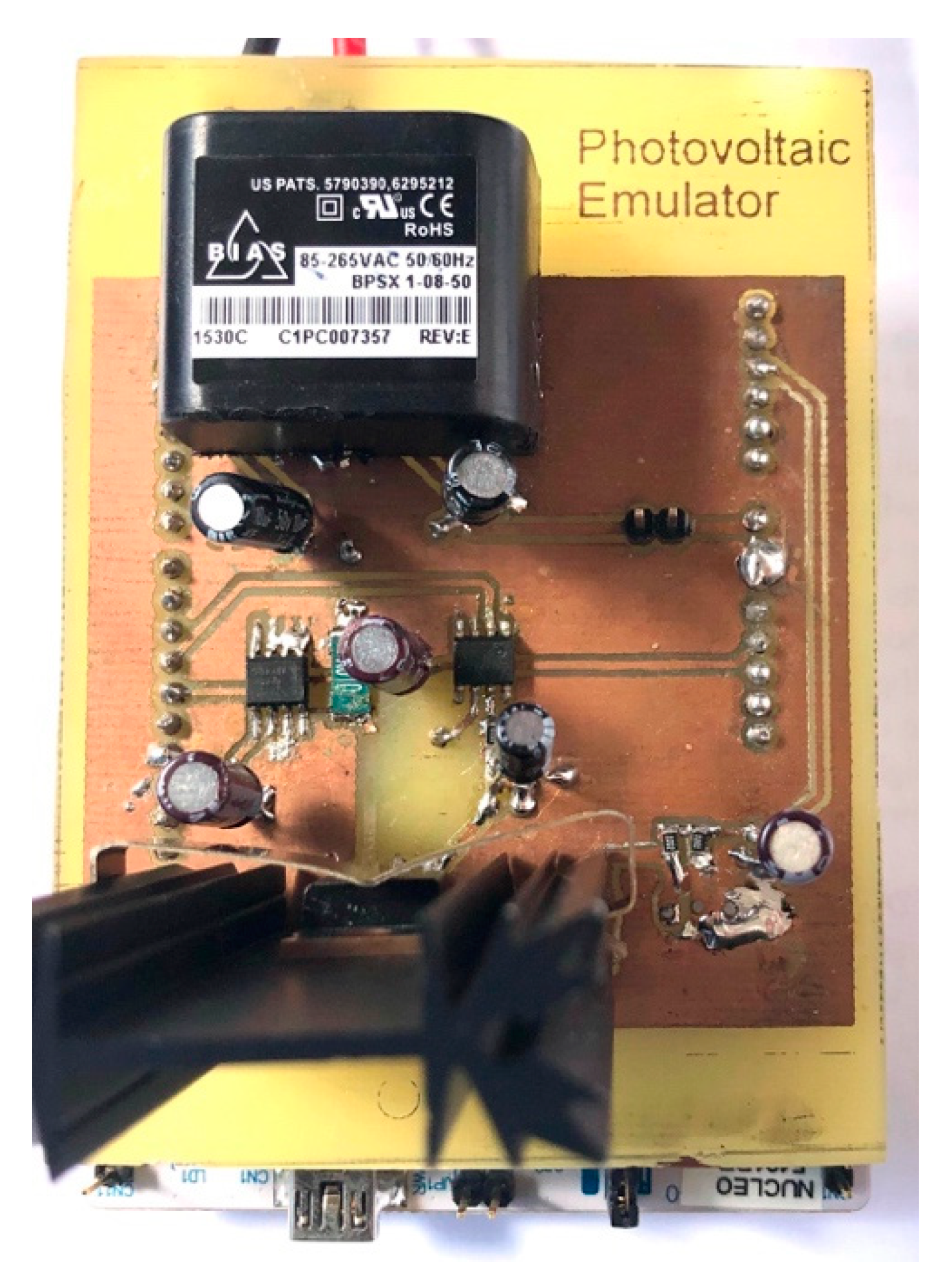
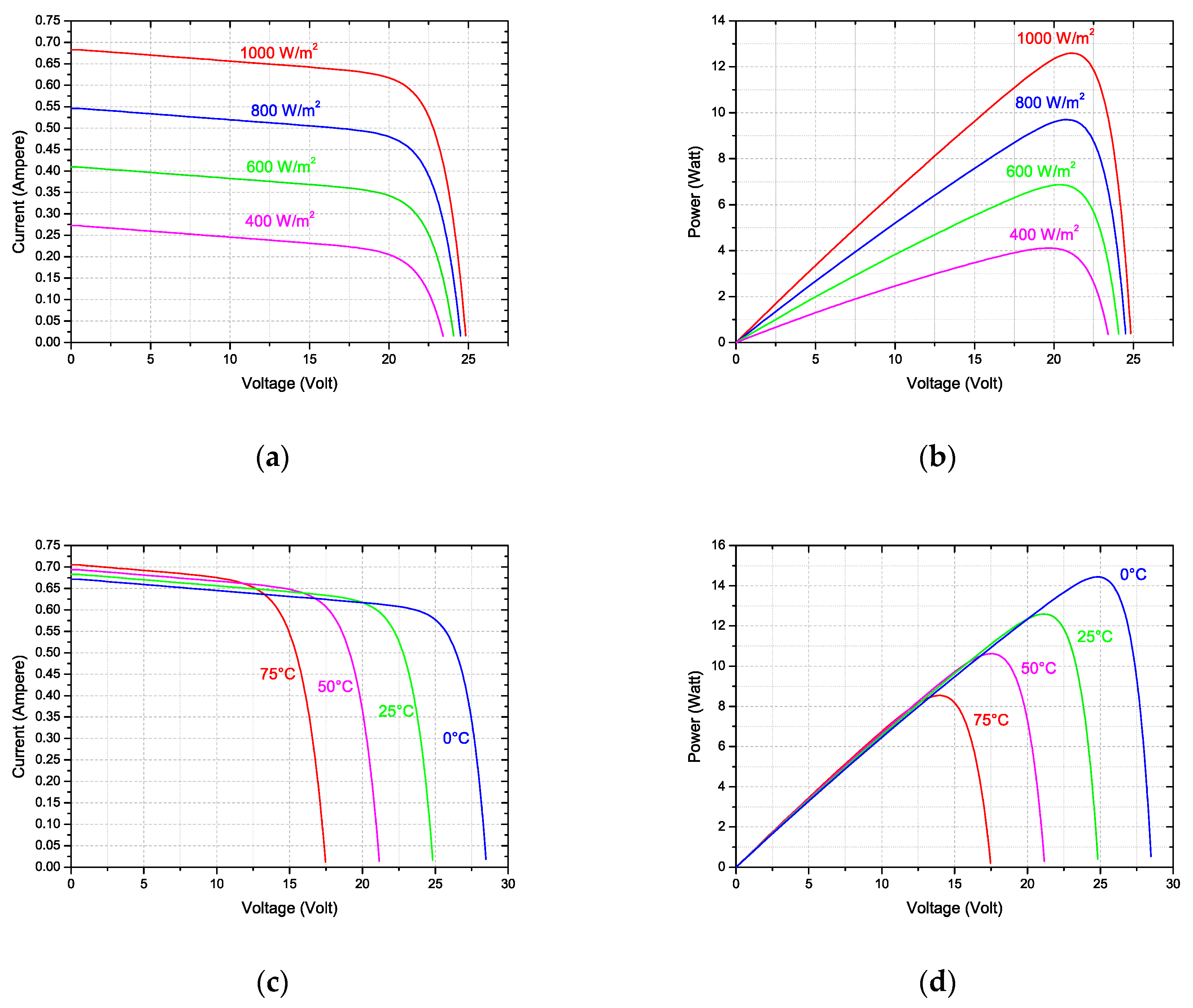
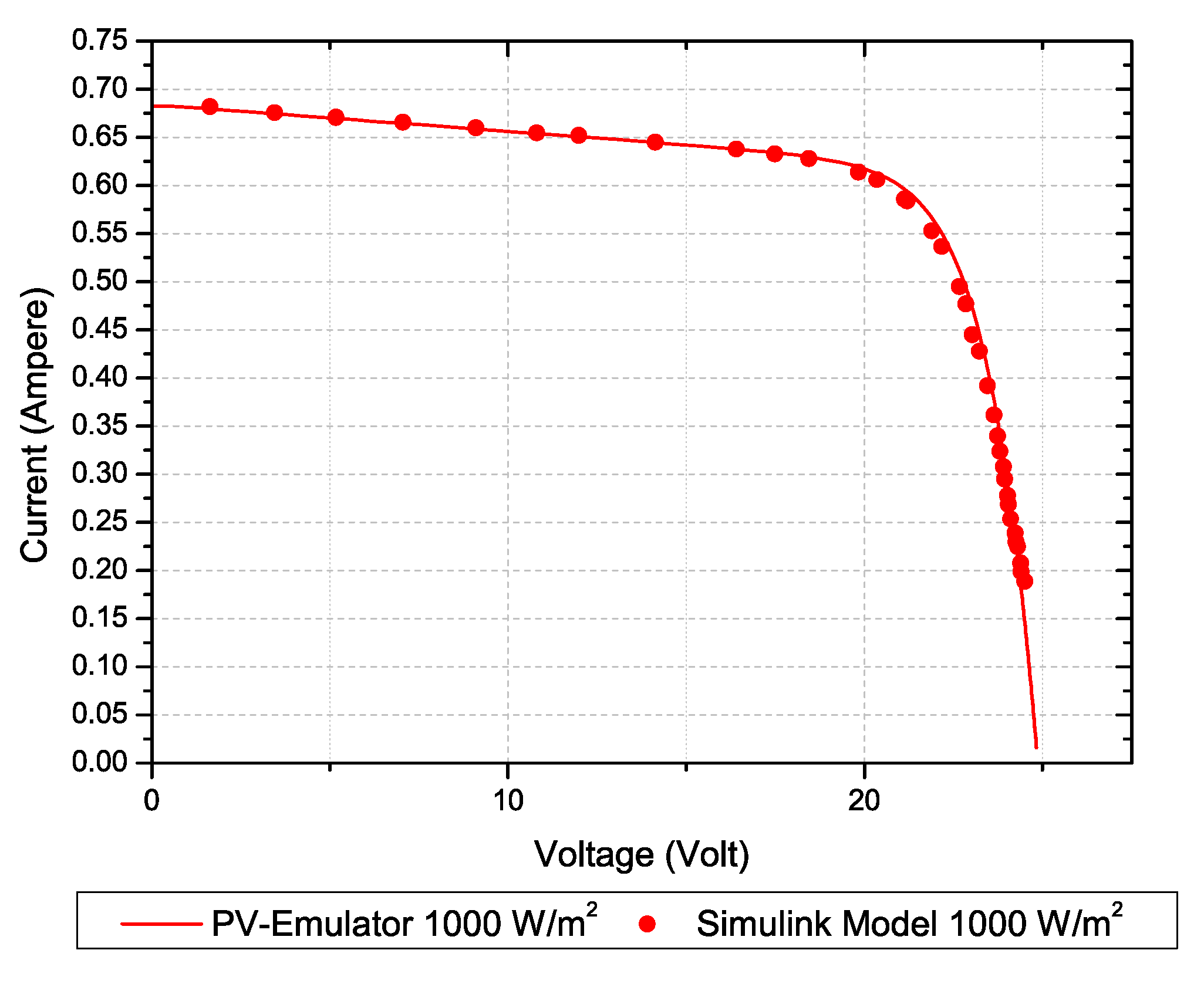
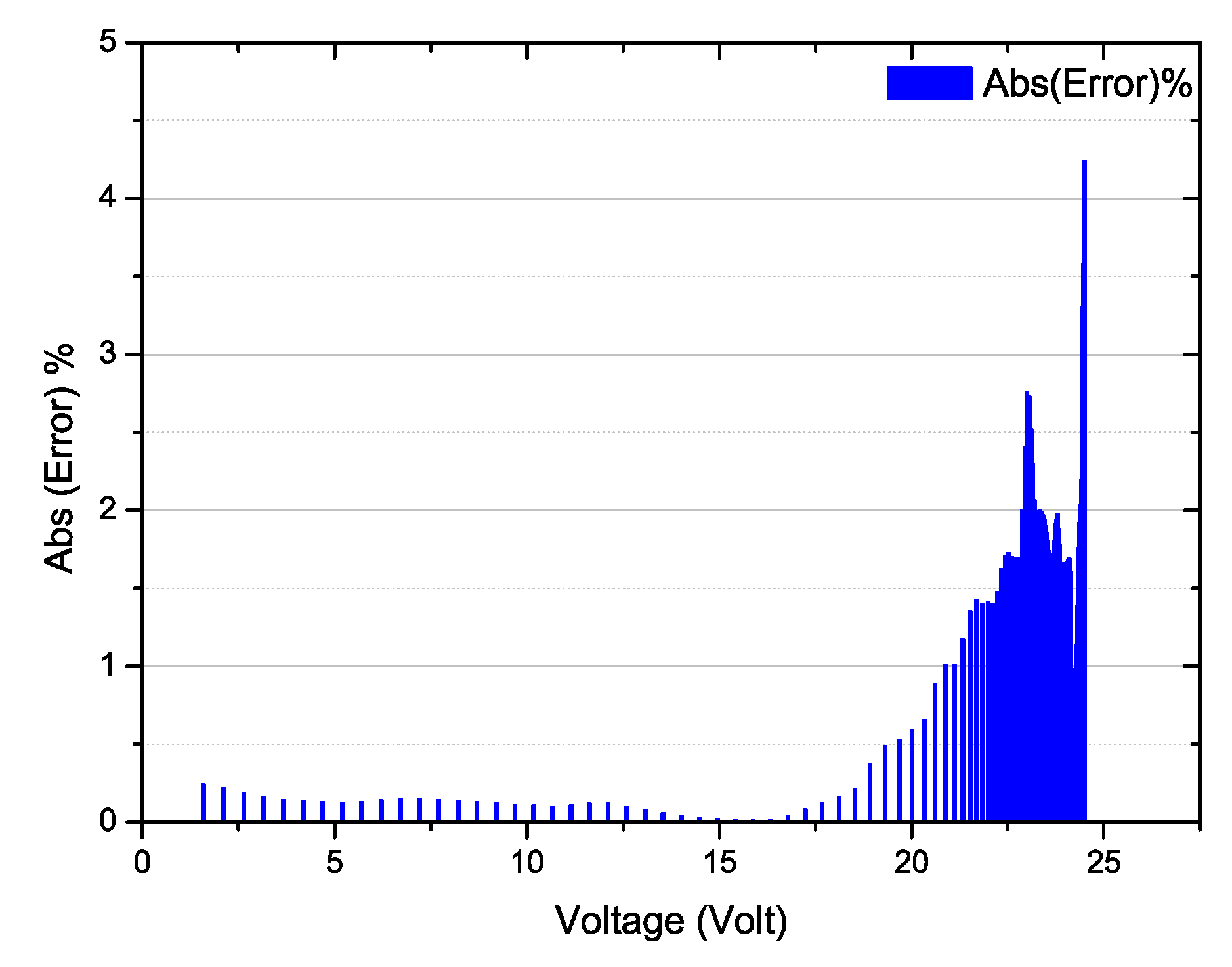
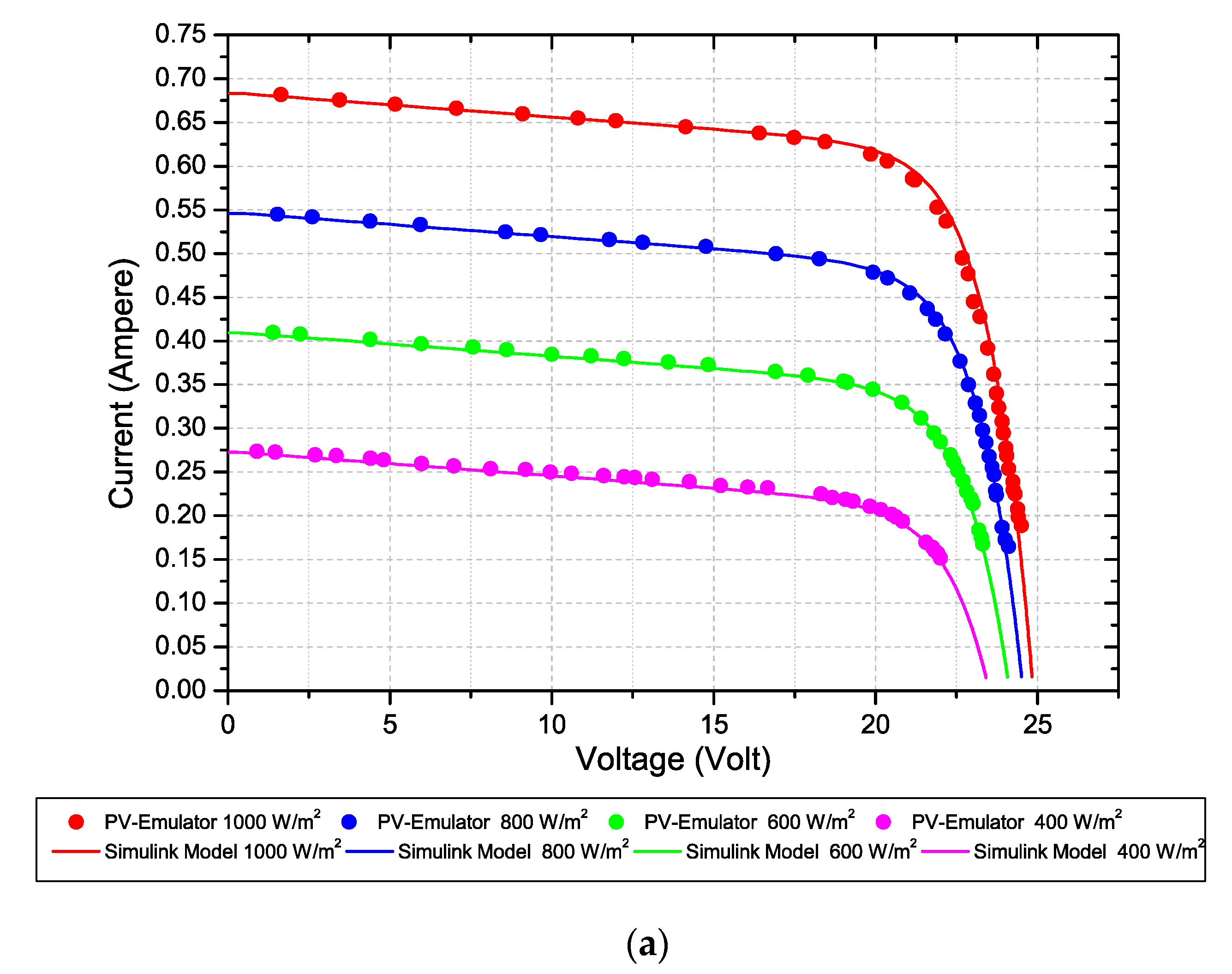
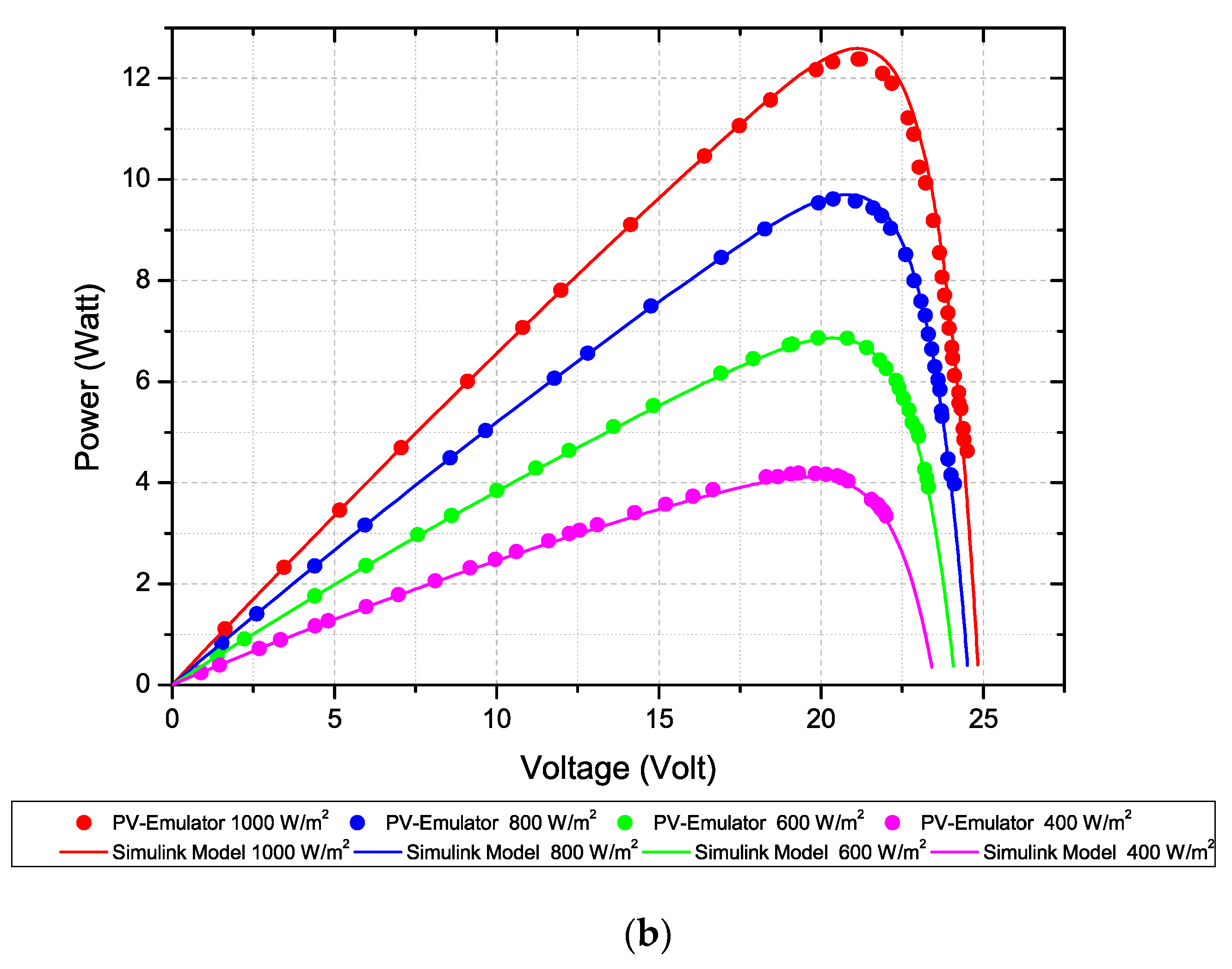
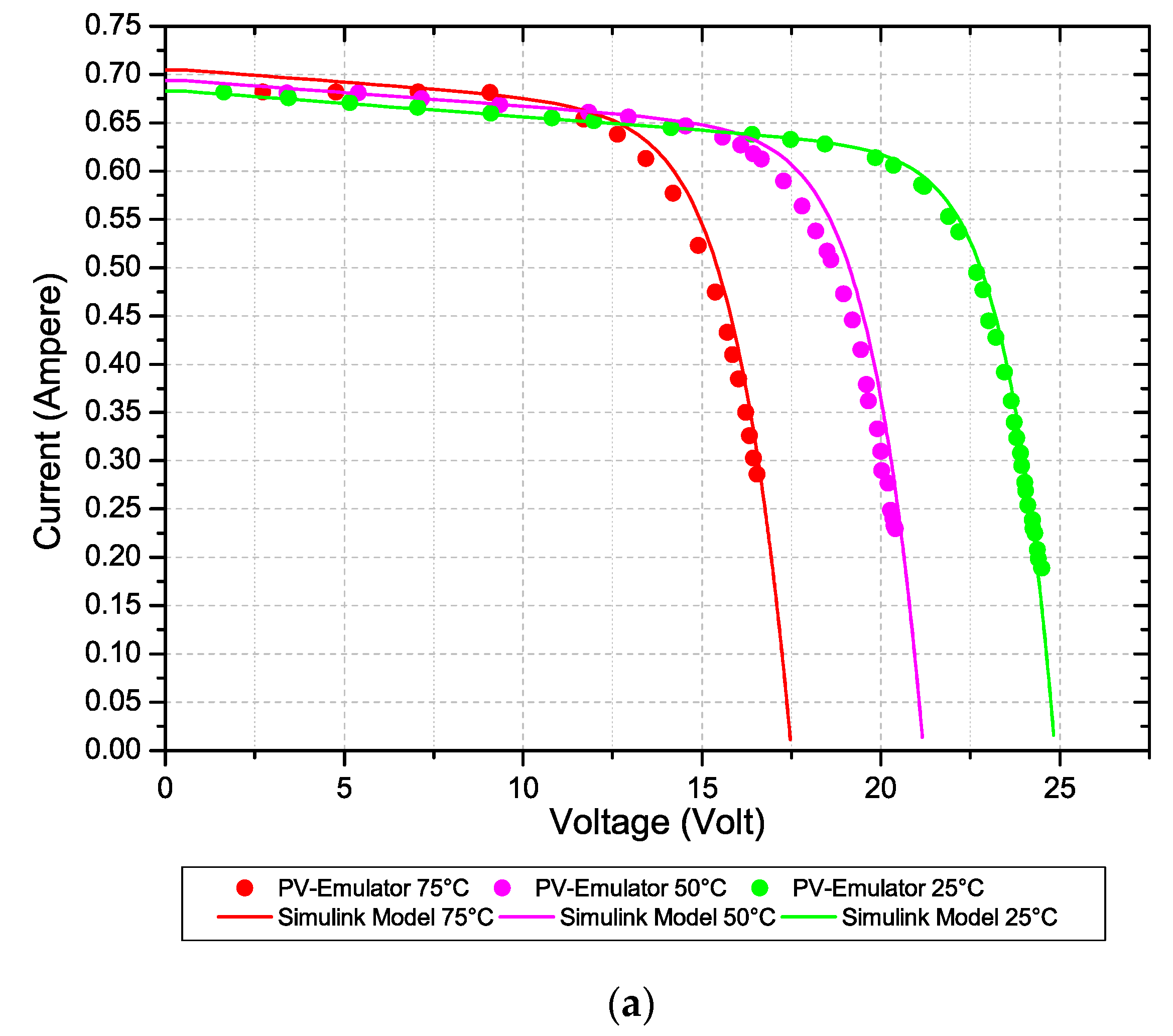
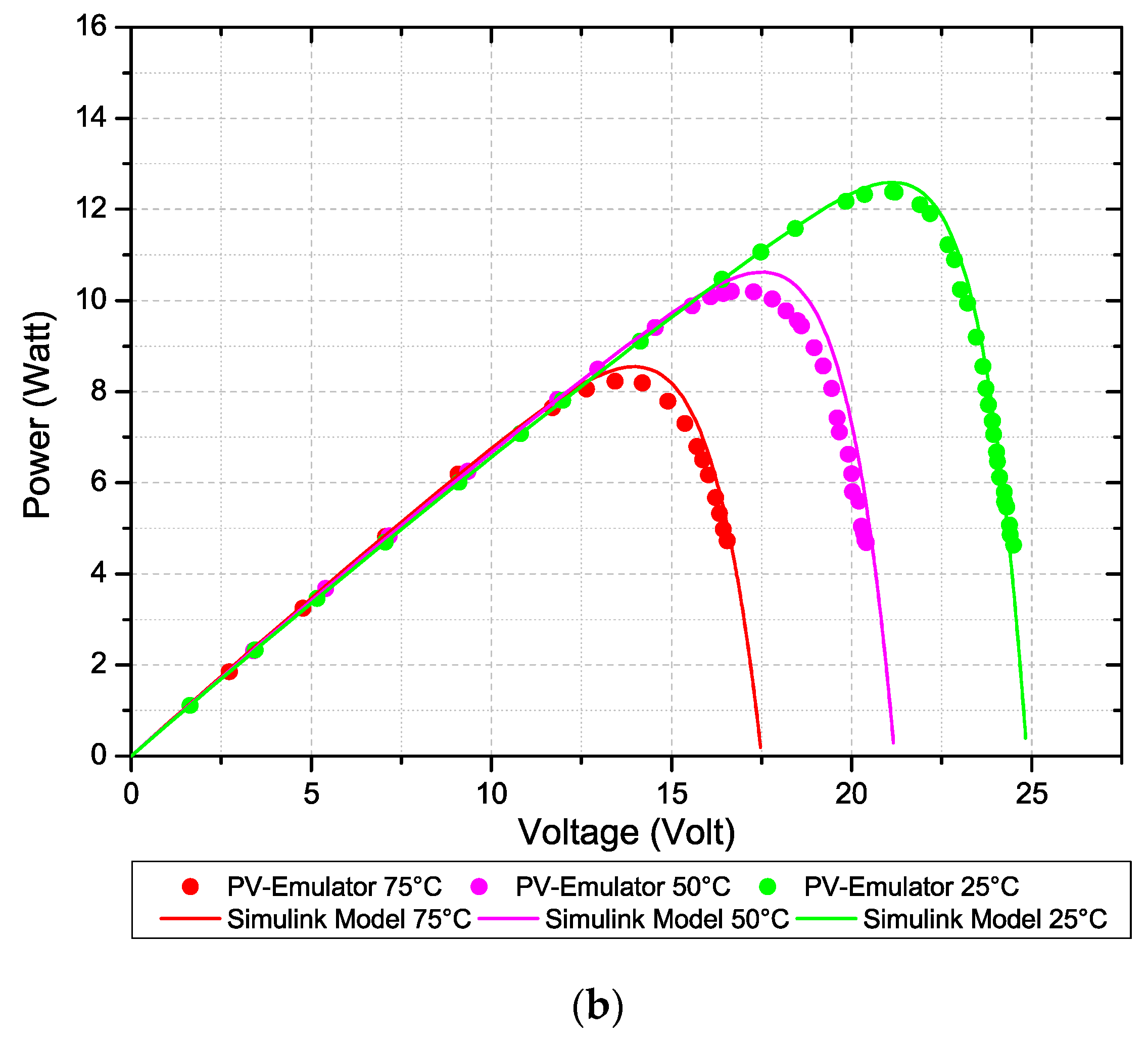
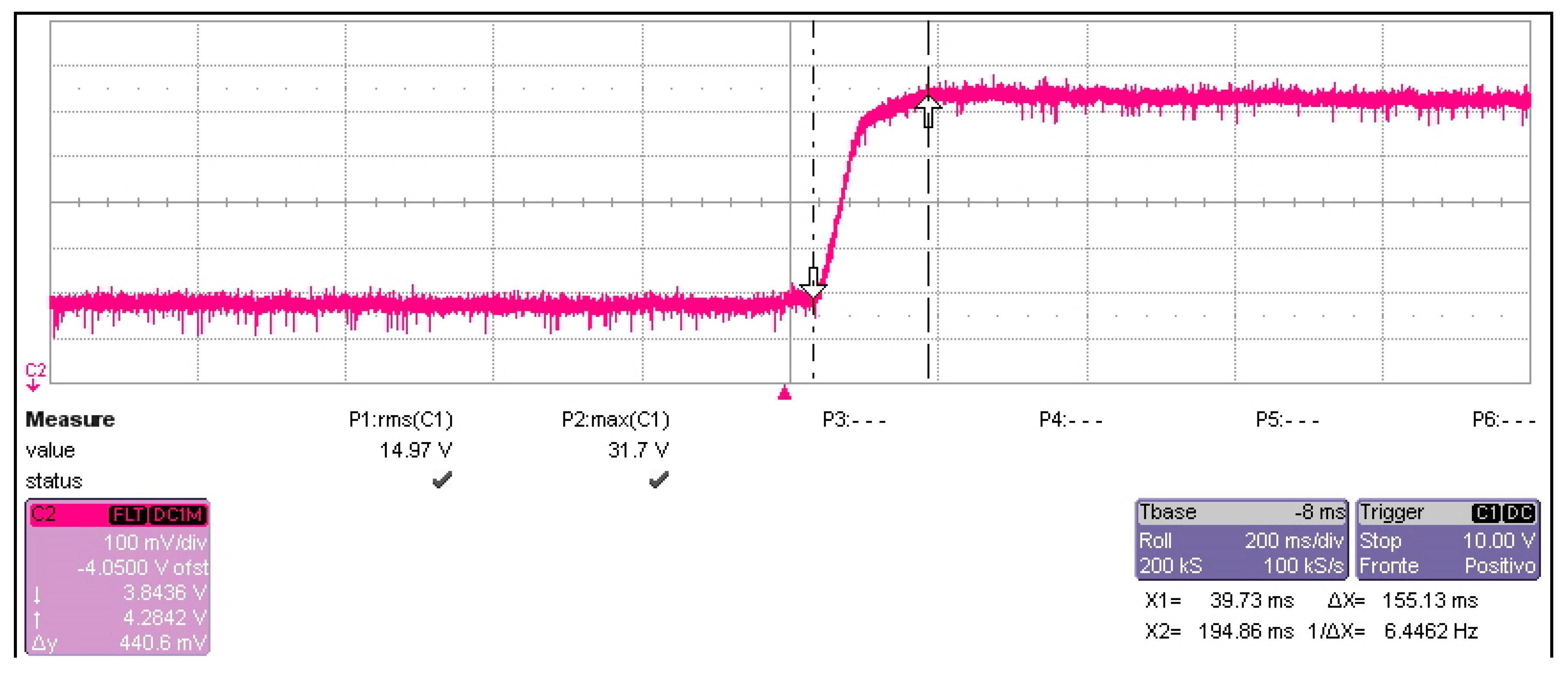
| Parameter | Value |
|---|---|
| Typical Peak Power (PMPP) | 12 W |
| Short circuit Current (ISC) | 0.683 A |
| Open circuit Voltage (VOC) | 25 V |
| Temperature coefficient of Open-Circuit Voltage (kV) | −(80 ± 10) mV/°C |
| Temperature coefficient of Short circuit Current (kI) | (0.065 ± 0.015) %/°C |
| Temperature coefficient of Power | (0.5 ± 0.05) %/°C |
| Nominal Operating Cell Temperature (NOCT) | 47 ± 2 °C |
© 2019 by the authors. Licensee MDPI, Basel, Switzerland. This article is an open access article distributed under the terms and conditions of the Creative Commons Attribution (CC BY) license (http://creativecommons.org/licenses/by/4.0/).
Share and Cite
Merenda, M.; Iero, D.; Carotenuto, R.; Della Corte, F.G. Simple and Low-Cost Photovoltaic Module Emulator. Electronics 2019, 8, 1445. https://doi.org/10.3390/electronics8121445
Merenda M, Iero D, Carotenuto R, Della Corte FG. Simple and Low-Cost Photovoltaic Module Emulator. Electronics. 2019; 8(12):1445. https://doi.org/10.3390/electronics8121445
Chicago/Turabian StyleMerenda, Massimo, Demetrio Iero, Riccardo Carotenuto, and Francesco G. Della Corte. 2019. "Simple and Low-Cost Photovoltaic Module Emulator" Electronics 8, no. 12: 1445. https://doi.org/10.3390/electronics8121445
APA StyleMerenda, M., Iero, D., Carotenuto, R., & Della Corte, F. G. (2019). Simple and Low-Cost Photovoltaic Module Emulator. Electronics, 8(12), 1445. https://doi.org/10.3390/electronics8121445








